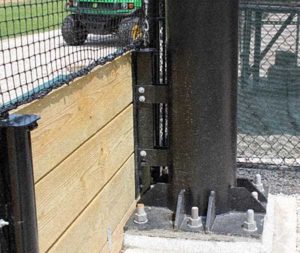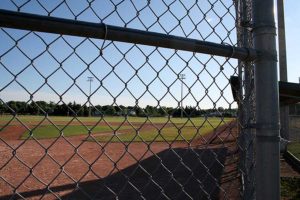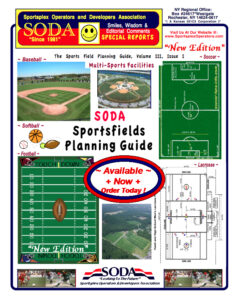Mar 17, 2020 · Beacon Athletics
► NETTING: What are the benefits?
- Visual appeal
- Fan safety
- Installation
- Cost
◾ VISUAL APPEAL
![]() Netting systems are visually impressive.They create a professional ballfield experience and provide minimal obstruction for viewing. Thin, black netting seamlessly blends into the ballfield and fewer poles mean fewer obstructions. The netting poles can even be installed behind the seating area giving fans a seamless view of the game.
Netting systems are visually impressive.They create a professional ballfield experience and provide minimal obstruction for viewing. Thin, black netting seamlessly blends into the ballfield and fewer poles mean fewer obstructions. The netting poles can even be installed behind the seating area giving fans a seamless view of the game.
◾ SAFETY
Backstop netting systems provide superior spectator protection.Chain link fences can make it difficult for fans to see the game, and many will move to an unprotected area for a better view. Netting systems can be installed to greater heights than chain link fences, so the risk of foul balls flying into the viewing area is lower. While the most common height for netting systems is 30 feet, 10 feet higher than a chain link fence, they can be installed up to 50 feet. These increased heights prevent errant balls from hitting cars, buildings, and spectators without sacrificing the viewer’s ability to see the game. Besides backstop safety, barrier netting is often installed down the foul lines. Set at a height of 10 to 20 feet, this helps protect pitchers and catchers who are warming up, as well as spectators who are entering and exiting the facilities.
◾ INSTALLATION
 Netting systems are configured to fit your needs exactly. A typical system will use four large, steel poles that are engineered based on the specific needs (height and netting span) of your ballpark. These poles offer you flexibility in their placement – they can be placed down the foul lines, behind dugouts or seating areas, and can be configured to work around existing buildings. These solid poles are designed to withstand the stress that is created by wind at your park.
Netting systems are configured to fit your needs exactly. A typical system will use four large, steel poles that are engineered based on the specific needs (height and netting span) of your ballpark. These poles offer you flexibility in their placement – they can be placed down the foul lines, behind dugouts or seating areas, and can be configured to work around existing buildings. These solid poles are designed to withstand the stress that is created by wind at your park.
Netting systems need to be secured to the backstop wall, as well as secured to the grandstand or dugout areas. If not engineered and installed correctly from the beginning, this will likely cause future issues. For example, a backstop wall constructed of hollow blocks will not provide the holding strength for the eye bolts holding the lower horizontal cables.
In order to reduce the amount of give the net has when a ball hits it, proper installation is essential. If not correctly installed, the tension of the net can be compromised and the net will flex too much when hit by a ball. This can put nearby fans who are “nose to net”at risk.
◾ COST
A wide range of factors means there is a wide range of final costs.First, you must consider some essential factors that will drive cost and design: the height of the net, the number of poles and their overall span, the pole placement (inline with the backstop, offset behind the home plate seating area, and placement in relation to the dugout), and whether the poles are buried or mounted to a plate. Large redesigns or initial builds can benefit from the cost savings provided by a netting system — huge chain link fencing projects come with huge price tags. While less expensive at the onset, even small chain link fences will require replacing down the road. After installation, the only future expense of your netting system will be replacing or patching the net. They cover a large area, and provide the most cost economical way to protect a large number of fans.
►NETTING: What else should I consider?
- Durability
- Backstop use
- Netting material
- Give of the material (flex)
- Other budget considerations
◾ DURABILITY
Depending on your location, some backstop netting systems can be left up all year. In colder climates, a winch-based lift and tension netting system requires the field maintenance staff to take it down and to store it with care. A permanent netting system only needs the net removed in the case of an extreme storm. Properly maintained, a netting system will last eight to twelve years. Tears or holes can develop, but can be easily repaired. Netting systems can also be susceptible to vandalism if there is no park security.
◾ BACKSTOP USE
Backstop netting systems are meant to be installed with a solid backstop wall, and are not meant to go directly to the field surface. Contact with cleats and balls at the ground level would create tears and holes. In the absence of a backstop wall, a netting system can be added to a 4 to 6 foot chain link base wall.
◾ NETTING MATERIAL
The netting used for backstop netting systems must be strong, but flexible in order to resist stress created by wind. The type of fiber used in the netting system, paired with the design of the system, determines its strength and longevity. There are two main material options available, depending on your needs: nylon, and Dyneema.
The majority of netting systems use nylon. The stronger material means a longer lifespan, and can be used both indoors and outdoors. UV inhibitors extend the life of the netting, and varnish or latex dips make the material waterproof. Nylon provides your spectators with a clearer view of the field than the poly netting.
If you are outfitting a professional ballfield, Dyneema (a high-end Polypropylene type of material) provides the strongest and most visually appealing netting system. This material is ultra-strong yet ultra-lightweight, and offers minimal visual obstruction to spectators. It has a high resistance to UV degradation, but may need replacing more frequently than nylon netting systems.
◾ OTHER BUDGET CONSIDERATIONS
For ballfields with fencing systems under 20 feet in height,installing a backstop netting system at a similar height is a less cost efficient option. In that case, a chain link fence may be your best choice. The increased value of a netting system is really seen when you’re looking at heights from 20 to 50 feet, and beyond.
► CHAIN LINK FENCE: What are the benefits?
- Durability
- Safety
- Cost
◾ Durability
![]() Chain link fences are made from strong, high gauge metal that is meant to last for years. The posts can be concreted into place, and the fencing holds well against strong winds and the players who lean on them. Fence systems are typically installed straight to the ground, and will not become significantly damaged by balls or cleats hitting them.
Chain link fences are made from strong, high gauge metal that is meant to last for years. The posts can be concreted into place, and the fencing holds well against strong winds and the players who lean on them. Fence systems are typically installed straight to the ground, and will not become significantly damaged by balls or cleats hitting them.
◾ Safety
Chain link fences provide your ballfield with immovable protectionfrom errant hits, throws, and pitches. The strong metal will not give when a ball hits it, the ball will be stopped immediately, and the fence will not be severely damaged.
◾ Cost
For smaller backstops that are less than 20′ in height, chain link fences remain the most affordable option. Chain link systems require a smaller investment upfront and may be the best choice when working under a limited budget.
► CHAIN LINK FENCE: What else should I consider?
- Materials
- Obstructions
- Other budget considerations
◾ Materials
Metal is subject to rust and distortion over time, despite its strength. Years of being hit with balls can lead chain link fences to being bent or damaged behind the home plate area. Fencing often becomes bowed or bent over time and will later require large sections to be replaced at the same time.
◾ Obstructions
 Chain link fences give your ballpark a less professional atmosphere. The thickness of the metal, combined with the color of the steel, creates more prominent obstructions than netting systems. Poles must be placed every four to eight feet, and chain link fences often require additional horizontal supporting poles. Clear viewing of the ballgame is compromised and spectators may move to unprotected areas to be able to see the game. This reduces the protection your chain link system provides your fans.
Chain link fences give your ballpark a less professional atmosphere. The thickness of the metal, combined with the color of the steel, creates more prominent obstructions than netting systems. Poles must be placed every four to eight feet, and chain link fences often require additional horizontal supporting poles. Clear viewing of the ballgame is compromised and spectators may move to unprotected areas to be able to see the game. This reduces the protection your chain link system provides your fans.
◾ Other budget considerations
Outfitting a ballpark with a chain link fence heights available in taller netting systems would be cost prohibitive. The typical chain link fence system does not exceed 20 feet in height, and extending it beyond that would require a much more extensive budget. When considering the amount of materials needed and the cost of installation, chain link fences may not be a suitable choice for larger scaled ballparks. Even if a shorter chain link fence requires a lower initial investment, eventual damage to the fence will require higher costs to repair it down the road.
. . . . . . . . . . . . . . . . . . . . . . . . . . . . . . . . . . . . . .
We Can Save You Money In 2020 !
* ( 16 Different Amateur Sports ) *
( Teams, Officials, Tournaments, & Facilities ) *
1-800-622-7370
. . . . . . . . . . . . . . . . . . . . . . . .
www.sadlersports.com/soda
. . . . . . . . . . . . . . . . . . . . . . . .
“Proudly Serving The USA/Canada





I thought it was interesting when you mentioned that chain link fences are great for ballparks because they stop moving objects immediately. I would think that it would be a good idea to perform regular maintenance on chain link fences in order to keep them in good shape. It seems like a metal fence would last for a long time if it is kept in good condition.
Thanks for the input !
Happy New Year !
S O D A